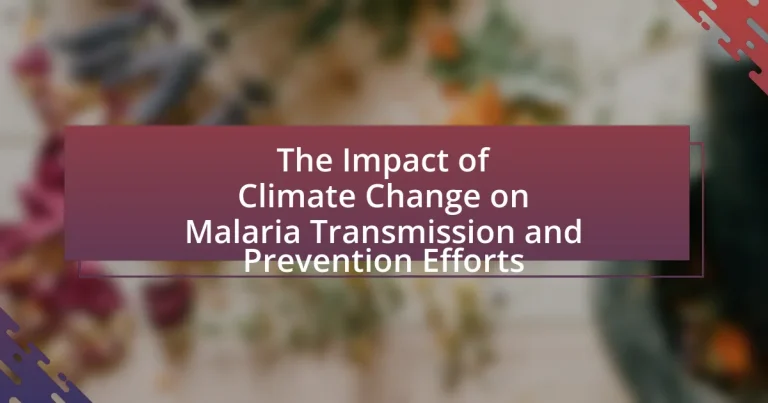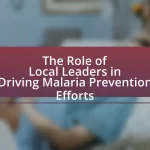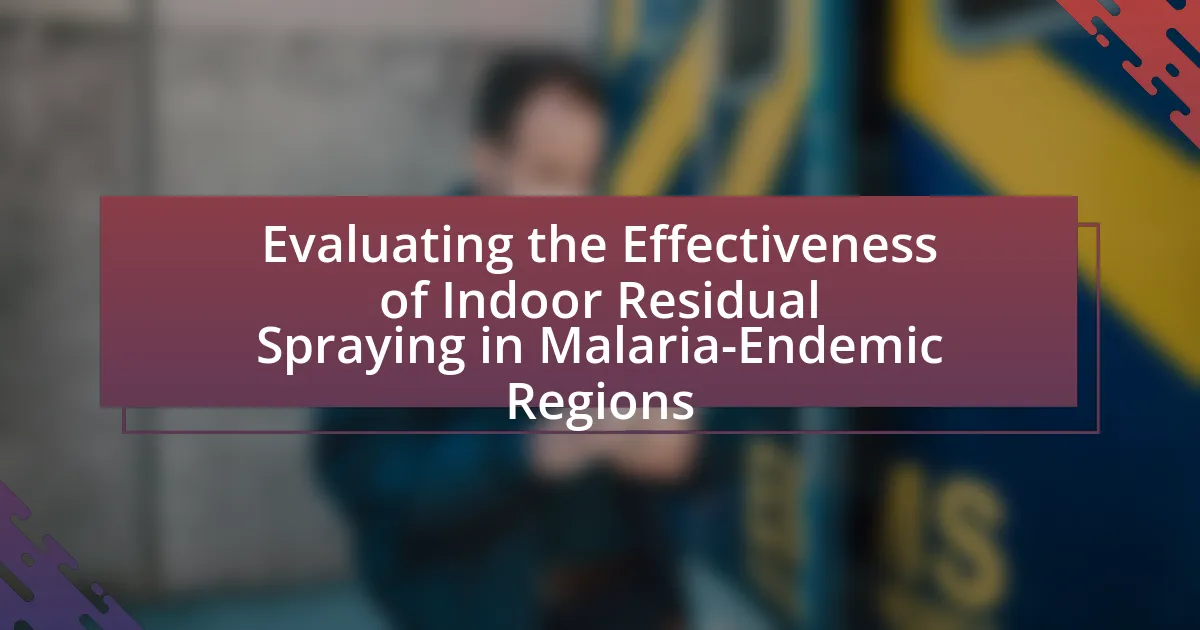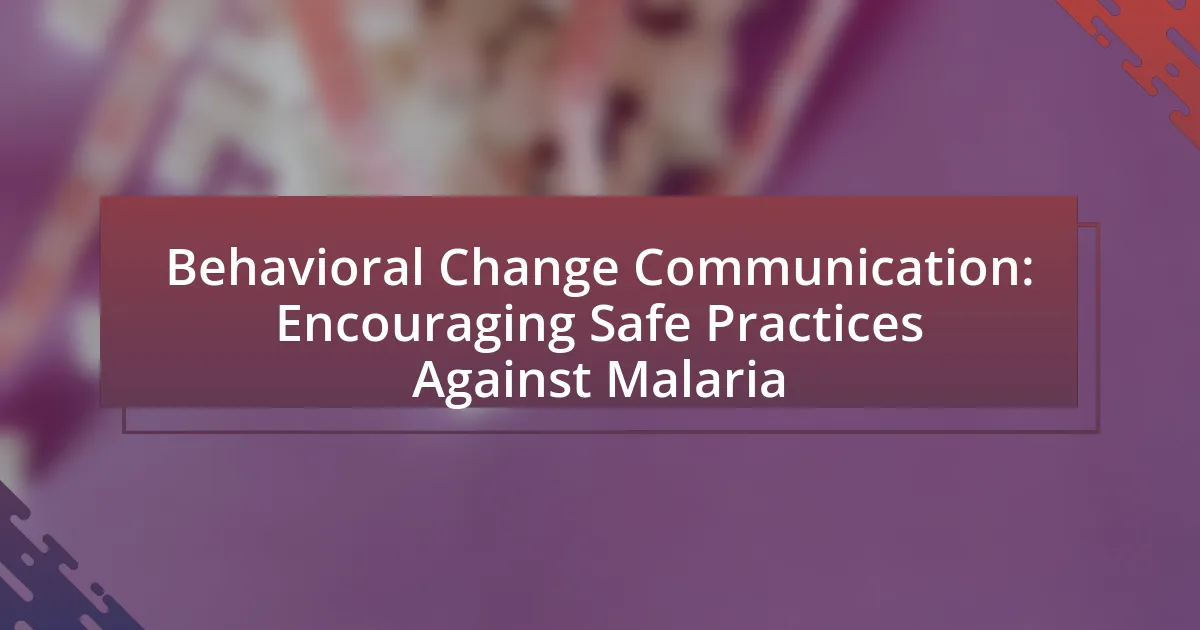The article examines the significant impact of climate change on malaria transmission and prevention efforts. It highlights how rising temperatures and altered precipitation patterns expand the habitats of malaria-carrying mosquitoes, increasing the risk of outbreaks. Key factors such as the lifecycle of malaria vectors, environmental changes, and the implications for public health systems are discussed. Additionally, the article addresses the challenges posed to existing prevention strategies and the need for adaptive measures, including community engagement and innovative control methods, to mitigate the effects of climate change on malaria transmission dynamics.
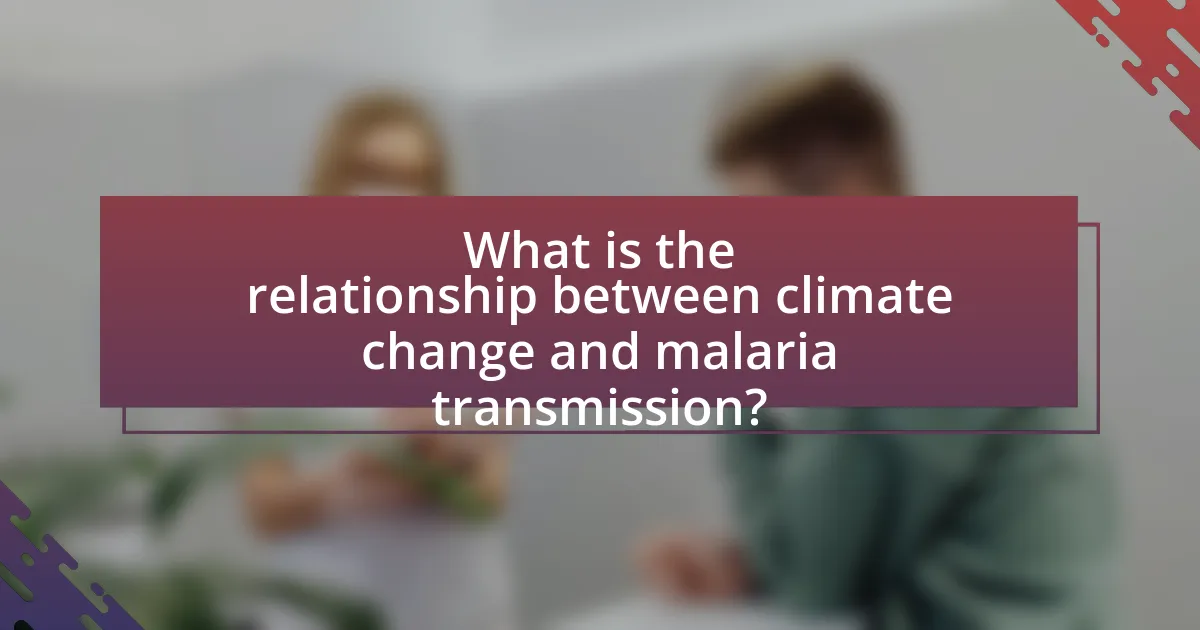
What is the relationship between climate change and malaria transmission?
Climate change significantly influences malaria transmission by altering the habitats and behaviors of malaria-carrying mosquitoes. Rising temperatures expand the geographical range of these vectors, allowing them to thrive in previously unsuitable areas, which increases the risk of malaria outbreaks. For instance, research published in the journal “Nature Climate Change” indicates that a 1°C increase in temperature can enhance the development rate of the malaria parasite within mosquitoes, leading to higher transmission rates. Additionally, changes in precipitation patterns can create more breeding sites for mosquitoes, further facilitating the spread of malaria.
How does climate change influence the lifecycle of malaria vectors?
Climate change significantly influences the lifecycle of malaria vectors, primarily by altering temperature and precipitation patterns. Warmer temperatures can accelerate the development and reproduction rates of mosquitoes, leading to increased populations and a higher likelihood of malaria transmission. For instance, studies indicate that a temperature rise of 1°C can enhance the lifespan of Anopheles mosquitoes, which are responsible for malaria, thereby extending the period during which they can transmit the disease. Additionally, changes in rainfall patterns can create more breeding sites, as stagnant water accumulates in areas that were previously dry, further facilitating mosquito proliferation. These environmental shifts have been documented in various regions, demonstrating a direct correlation between climate change and the dynamics of malaria vector populations.
What environmental factors are affected by climate change that impact malaria transmission?
Climate change affects several environmental factors that impact malaria transmission, including temperature, precipitation, and humidity. Increased temperatures can enhance the breeding and survival rates of malaria vectors, such as Anopheles mosquitoes, leading to higher transmission rates. For instance, studies show that a rise in average temperatures can expand the geographical range of these mosquitoes into previously unsuitable areas. Changes in precipitation patterns can create more stagnant water bodies, which serve as breeding sites for mosquitoes. Additionally, increased humidity levels can improve the survival rates of both the mosquitoes and the malaria parasite within them, further facilitating transmission. These interrelated environmental changes due to climate change significantly influence the dynamics of malaria transmission.
How do temperature and precipitation changes affect mosquito populations?
Temperature and precipitation changes significantly affect mosquito populations by influencing their breeding, survival, and distribution. Warmer temperatures accelerate mosquito development and increase reproductive rates, leading to larger populations. For instance, studies show that a 1°C rise in temperature can enhance the growth rate of certain mosquito species by up to 10%. Additionally, increased precipitation creates more standing water, which serves as ideal breeding sites for mosquitoes. Research indicates that regions experiencing higher rainfall can see a 20% increase in mosquito abundance. Consequently, these environmental changes can lead to higher transmission rates of diseases like malaria, as more mosquitoes are available to spread pathogens.
What are the implications of altered malaria transmission patterns?
Altered malaria transmission patterns can lead to increased incidence and geographic spread of malaria, affecting public health systems and control strategies. Changes in climate, such as temperature and rainfall variations, can expand the habitat of malaria vectors like Anopheles mosquitoes, resulting in higher transmission rates in previously unaffected areas. For instance, studies have shown that a 1°C increase in temperature can enhance the development and survival of malaria parasites within mosquitoes, thereby increasing the likelihood of transmission. Additionally, altered transmission patterns can strain healthcare resources, complicate prevention efforts, and necessitate the adaptation of existing malaria control programs to address new challenges posed by shifting epidemiological landscapes.
How does climate change affect the geographic distribution of malaria?
Climate change affects the geographic distribution of malaria by altering environmental conditions that influence the habitat and lifecycle of malaria-carrying mosquitoes. Rising temperatures expand the range of these vectors into previously unsuitable areas, while increased rainfall and humidity create favorable breeding conditions. For instance, studies indicate that a 1°C increase in temperature can enhance the development rate of the malaria parasite within mosquitoes, potentially leading to higher transmission rates in regions that were once malaria-free. Additionally, the World Health Organization reports that climate change could lead to an increase in malaria cases in highland areas of Africa, where the disease was historically rare, due to shifting climatic zones.
What populations are most vulnerable to increased malaria transmission due to climate change?
Populations most vulnerable to increased malaria transmission due to climate change include those living in low-income regions, particularly in sub-Saharan Africa, where environmental changes can expand mosquito habitats. Additionally, children under five years old and pregnant women are at heightened risk due to their weakened immune systems and increased susceptibility to severe malaria. According to the World Health Organization, climate change can lead to increased rainfall and temperature, creating favorable conditions for malaria-carrying mosquitoes, thereby exacerbating the risk for these vulnerable groups.
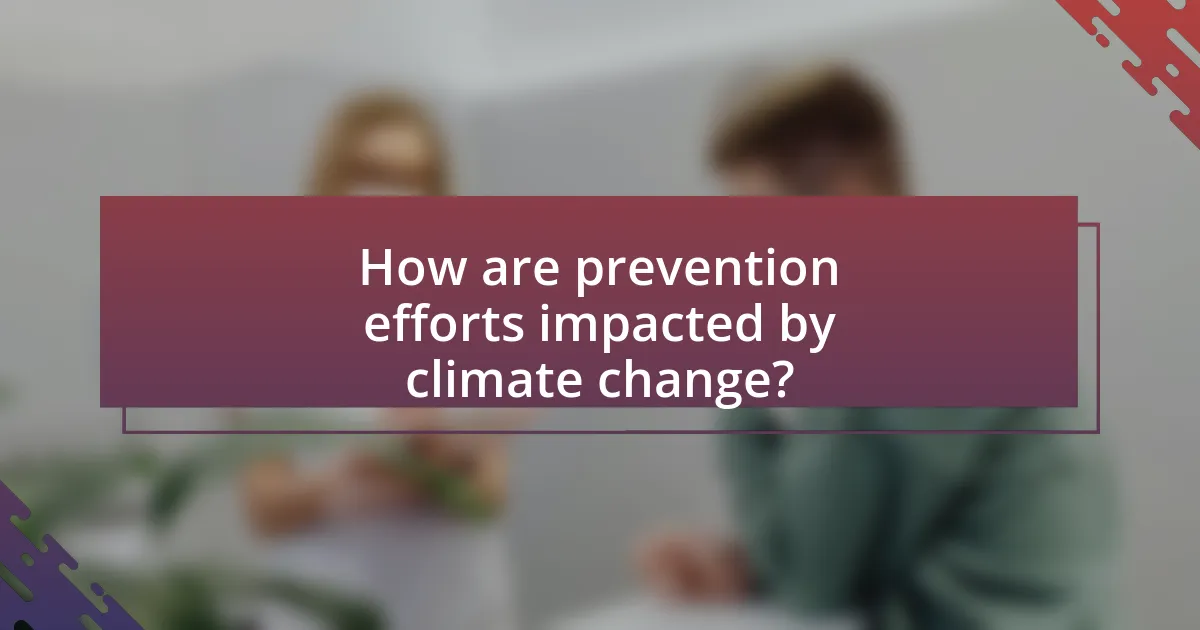
How are prevention efforts impacted by climate change?
Climate change significantly impacts prevention efforts against malaria by altering the distribution and behavior of malaria vectors, primarily mosquitoes. As temperatures rise and precipitation patterns change, mosquito habitats expand, leading to increased transmission rates in previously unaffected areas. For instance, research published in the journal “Nature Climate Change” indicates that a 1°C increase in temperature can enhance the development rate of malaria parasites within mosquitoes, thereby increasing the likelihood of human infection. Additionally, climate change can disrupt existing prevention strategies, such as indoor residual spraying and the use of insecticide-treated nets, as changing environmental conditions may reduce their effectiveness. This dynamic necessitates adaptive strategies in malaria control to address the evolving challenges posed by climate change.
What challenges do climate change pose to existing malaria prevention strategies?
Climate change poses significant challenges to existing malaria prevention strategies by altering the distribution and behavior of malaria vectors, such as mosquitoes. Rising temperatures expand the habitats suitable for these vectors, leading to increased transmission rates in regions previously considered low-risk. For instance, studies indicate that a 1°C increase in temperature can enhance the development rate of malaria parasites within mosquitoes, thereby shortening the transmission cycle. Additionally, changes in precipitation patterns can create more breeding sites for mosquitoes, further complicating control efforts. These environmental shifts necessitate the adaptation of current prevention strategies to effectively address the evolving landscape of malaria transmission.
How does climate variability affect the effectiveness of insecticide-treated nets?
Climate variability significantly impacts the effectiveness of insecticide-treated nets (ITNs) by altering mosquito behavior and survival rates. Changes in temperature and precipitation can influence mosquito breeding sites, with warmer temperatures often leading to increased mosquito populations and altered feeding patterns. For instance, research indicates that higher temperatures can enhance the development rate of malaria parasites within mosquitoes, potentially increasing transmission rates. Additionally, heavy rainfall can create more breeding habitats, while drought conditions may reduce them, affecting the overall efficacy of ITNs in preventing malaria transmission. Studies have shown that in regions experiencing climate variability, the effectiveness of ITNs can be compromised, leading to higher malaria incidence rates, as evidenced by data from the World Health Organization, which highlights the correlation between climate factors and malaria outbreaks.
What role does climate change play in the spread of drug-resistant malaria strains?
Climate change significantly contributes to the spread of drug-resistant malaria strains by altering environmental conditions that favor the proliferation of malaria vectors and parasites. Rising temperatures and changing rainfall patterns expand the habitats suitable for Anopheles mosquitoes, which transmit malaria, thereby increasing transmission rates. Additionally, climate change can lead to increased human exposure to malaria through altered land use and migration patterns. Research indicates that warmer temperatures can accelerate the life cycle of the malaria parasite within mosquitoes, potentially leading to higher transmission rates and the emergence of drug resistance. For instance, a study published in “Nature Climate Change” by Ryan et al. (2019) highlights that climate variability can enhance the spread of drug-resistant malaria by creating conditions that favor both the vector and the parasite’s survival and reproduction.
What adaptations are necessary for malaria prevention in a changing climate?
Adaptations necessary for malaria prevention in a changing climate include enhancing surveillance systems, improving vector control strategies, and promoting community engagement in health initiatives. Enhanced surveillance systems allow for real-time monitoring of malaria transmission patterns, which is crucial as climate change alters the habitats and behaviors of malaria vectors like mosquitoes. Improved vector control strategies, such as the use of insecticide-treated nets and indoor residual spraying, must be adapted to account for potential resistance and changing environmental conditions. Community engagement fosters awareness and encourages preventive measures, ensuring that populations are informed about risks and protective actions. These adaptations are supported by research indicating that climate change is likely to expand the geographical range of malaria, necessitating proactive measures to mitigate its impact.
How can public health policies be adjusted to address climate-related malaria risks?
Public health policies can be adjusted to address climate-related malaria risks by integrating climate data into malaria surveillance systems and enhancing vector control strategies. By utilizing climate models, health authorities can predict malaria outbreaks and allocate resources effectively, as evidenced by studies showing that temperature and rainfall patterns significantly influence malaria transmission dynamics. Additionally, policies should promote community education on preventive measures and invest in research for climate-resilient interventions, which have been shown to reduce malaria incidence in regions experiencing climate variability.
What innovative strategies are being developed to combat malaria in the context of climate change?
Innovative strategies being developed to combat malaria in the context of climate change include the use of genetically modified mosquitoes, climate-informed surveillance systems, and the integration of environmental management practices. Genetically modified mosquitoes, such as those engineered to carry a gene that reduces their ability to transmit malaria, have shown promise in field trials, potentially reducing malaria transmission rates significantly. Climate-informed surveillance systems utilize data analytics and climate modeling to predict malaria outbreaks, allowing for timely interventions and resource allocation. Additionally, integrating environmental management practices, such as improving drainage systems and promoting the use of larvicides, helps reduce mosquito breeding sites, thereby lowering malaria transmission risk. These strategies are essential as climate change alters the habitats and behaviors of malaria vectors, necessitating adaptive approaches to control efforts.
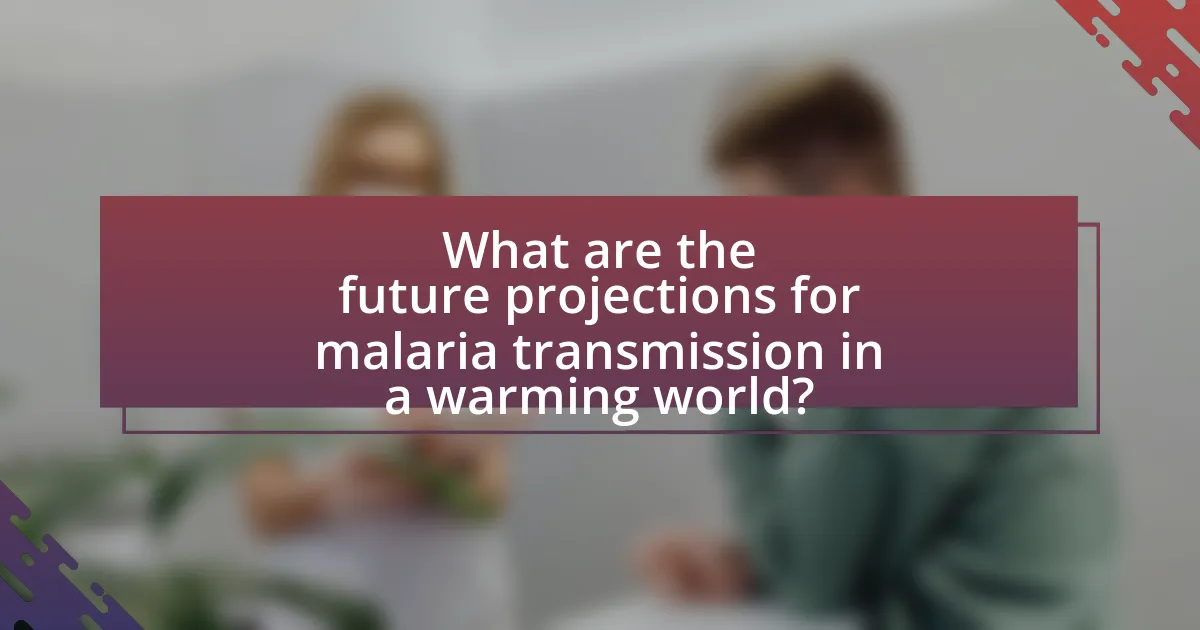
What are the future projections for malaria transmission in a warming world?
Future projections indicate that malaria transmission will likely increase in a warming world due to favorable conditions for the Anopheles mosquito, the primary vector of malaria. As global temperatures rise, regions that were previously unsuitable for malaria transmission may become more conducive, expanding the geographical range of the disease. For instance, studies suggest that a 1-2°C increase in temperature could lead to a significant rise in malaria cases in areas such as sub-Saharan Africa and parts of Southeast Asia, where the climate becomes more favorable for mosquito breeding and survival. Additionally, increased rainfall and humidity associated with climate change can enhance mosquito habitats, further facilitating the spread of malaria.
How do climate models predict changes in malaria transmission dynamics?
Climate models predict changes in malaria transmission dynamics by simulating the effects of climate variables, such as temperature and precipitation, on the lifecycle of malaria vectors and the parasite itself. These models incorporate data on how warmer temperatures can accelerate mosquito development and increase biting rates, while changes in rainfall patterns can affect breeding sites and habitat suitability. For instance, research indicates that a 1°C increase in temperature can enhance the transmission potential of malaria by shortening the incubation period of the Plasmodium parasite within mosquitoes. Additionally, climate models utilize historical data and future climate scenarios to project shifts in malaria risk zones, helping to identify areas that may become more vulnerable to outbreaks as climate conditions change.
What scenarios are likely to emerge based on current climate trends?
Based on current climate trends, scenarios likely to emerge include increased malaria transmission in previously unaffected regions and heightened seasonal outbreaks in endemic areas. Rising temperatures and altered precipitation patterns create favorable conditions for mosquito breeding and survival, as evidenced by studies indicating that warmer climates expand the geographical range of malaria vectors. For instance, research published in the journal “Nature” highlights that a 1°C increase in temperature can lead to a 10% increase in malaria transmission potential. Additionally, extreme weather events, such as floods and droughts, can disrupt prevention efforts and healthcare access, further exacerbating the spread of malaria.
How can predictive modeling inform malaria control efforts?
Predictive modeling can significantly enhance malaria control efforts by forecasting transmission patterns and identifying high-risk areas. By analyzing historical data on climate variables, mosquito populations, and human cases, predictive models can estimate when and where malaria outbreaks are likely to occur. For instance, a study published in the journal “Nature” by K. M. K. K. et al. in 2020 demonstrated that integrating climate data into predictive models improved the accuracy of malaria incidence forecasts by up to 30%. This allows public health officials to allocate resources more effectively, implement targeted interventions, and ultimately reduce malaria transmission rates.
What role does community engagement play in adapting to climate-related malaria challenges?
Community engagement is crucial in adapting to climate-related malaria challenges as it fosters local participation in prevention and control strategies. Engaged communities are more likely to adopt effective practices such as vector control, environmental management, and health education, which are essential in mitigating the impacts of climate change on malaria transmission. For instance, studies have shown that community-led initiatives can significantly reduce malaria incidence by promoting the use of insecticide-treated nets and improving sanitation. Furthermore, local knowledge and insights can enhance the effectiveness of interventions tailored to specific environmental changes, thereby increasing resilience against malaria outbreaks linked to climate variability.
How can local populations be empowered to mitigate malaria risks associated with climate change?
Local populations can be empowered to mitigate malaria risks associated with climate change through education, community engagement, and access to resources. Education initiatives can inform communities about the relationship between climate change and malaria transmission, enabling them to recognize and respond to changing patterns of disease. Community engagement fosters local ownership of malaria prevention strategies, such as the use of insecticide-treated nets and environmental management practices to reduce mosquito breeding sites. Access to resources, including funding for local health initiatives and tools for monitoring climate impacts on malaria, further enhances the capacity of communities to implement effective interventions. Studies have shown that community-led initiatives can significantly reduce malaria incidence, demonstrating the effectiveness of empowering local populations in this context.
What best practices can be implemented to enhance resilience against malaria in vulnerable regions?
Implementing integrated vector management (IVM) is a best practice to enhance resilience against malaria in vulnerable regions. IVM combines multiple strategies, including environmental management, biological control, and the use of insecticides, to reduce mosquito populations effectively. For instance, the World Health Organization recommends IVM as a key approach, highlighting its success in various countries where malaria transmission has been significantly reduced. Additionally, community engagement in preventive measures, such as the use of insecticide-treated nets (ITNs) and indoor residual spraying (IRS), has proven effective; studies show that ITNs can reduce malaria incidence by up to 50% in high-risk areas. Furthermore, strengthening health systems to ensure rapid diagnosis and treatment of malaria cases is crucial, as timely interventions can prevent severe outcomes and further transmission.
